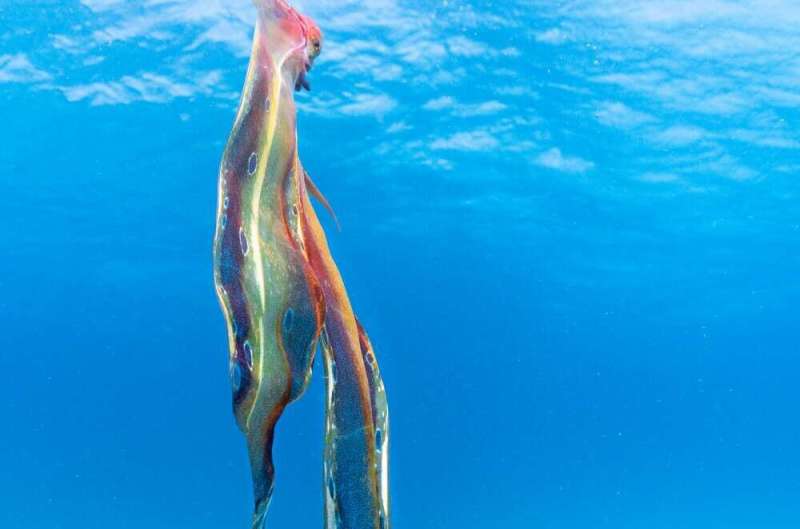January 17, 2022 report
Rare observation of a female blanket octopus in the wild

Marine biologist, photographer and videographer Jacinta Shackleton, has posted a video on Instagram of a female blanket octopus (with its psychedelic cape on full display) she came across earlier this month while snorkeling in the Great Barrier Reef. In her post, she notes that the blanket octopus is very rarely seen because it normally spends its time out in the open ocean.
The sighting came about as Shackleton was snorkeling in the reef near Lady Elliot Island, which is off the coast of Queensland. The blanket octopus is known for its beauty and its sexual size‐dimorphic—it belongs to the genus Tremoctopus. Females grow to an average length of two meters—the males, on the other hand grow to only about two and a half centimeters in length. The size difference is the largest in the animal kingdom and is believed to result in difficult procreation, particularly for the male who loses his hectocotylus (modified arm that delivers sperm) while mating and then dies. The female is resplendent with color and she has a technicolor cape that she can remove and leave behind when pursued by predators.
Shackleton describes the encounter as a once in a lifetime opportunity—only a handful of people have ever seen one in the wild. She notes that it took her a few moments to convince herself that what she was seeing was the infamous blanket octopus. She then began taking pictures of it and was even able to make a video of the encounter, which she notes was difficult due to her excitement. Her post on Instagram was noticed by a local news station and after reporting on her find, the video she made has been shown on news sites around the world.
Observations of the male blanket octopus are even more rare due to their smaller size—the first known observation occurred just 21 years ago. In addition to their smaller size, they also do not have the multicolored blanket or cape. Prior research has suggested the reason for the huge size difference between genders is tied to them carrying blue-bottle stingers they steal from jellyfish as a means of defense.
More information: M. D. Norman et al, First encounter with a live male blanket octopus: The world's most sexually size‐dimorphic large animal, New Zealand Journal of Marine and Freshwater Research (2010). DOI: 10.1080/00288330.2002.9517126
© 2022 Science X Network

















